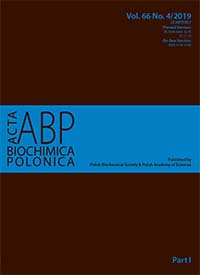Effect of glycosaminoglycans accumulation on the non-oxidative sulfur metabolism in mouse model of Sanfilippo syndrome, type B
Abstract
Lack of the N-alpha-acetylglucosaminidase gene is responsible for the occurrence of a rare disease – the Sanfilippo syndrome, type B. The result of this gene knock-out is accumulation of glycosaminoglycans (GAGs) – more specifically heparan sulfate – a sulfate rich macromolecule. The sulfur oxidative pathway is involved in the sulfate groups’ turnover in the cells. In contrast, the non-oxidative sulfur pathway leads mostly to formation of sulfane sulfur-containing compounds. The aim of our research was to observe an interaction between MPS IIIB and non-oxidative sulfur metabolism. In this work, we examined selected tissues (livers, kidneys, hearts and spleens) of 3 month old mice with confirmed accumulation of GAGs. The activity and expression of three sulfurtransferases (components of non-oxidative sulfur metabolism): rhodanese, 3-mercaptopyruvate sulfurtransferase and cystathionine γ-lyase was determined, as well as the sulfane sulfur level and the level of other low molecular sulfur-containing compounds (reduced and oxidized glutathione, cysteine and cystine). In all tested tissues, the sulfane sulfur and/or sulfurtransferases’ activities, as well as the cysteine content, underwent statistically significant changes. These correlations were also related to the sex of the tested animals. The obtained results indicated that accumulation of incompletely degraded GAGs in the tissues had affected the non-oxidative sulfur metabolism.
Acta Biochimica Polonica is an OpenAccess quarterly and publishes four issues a year. All contents are distributed under the Creative Commons Attribution-ShareAlike 4.0 International (CC BY 4.0) license. Everybody may use the content following terms: Attribution — You must give appropriate credit, provide a link to the license, and indicate if changes were made. You may do so in any reasonable manner, but not in any way that suggests the licensor endorses you or your use.
Copyright for all published papers © stays with the authors.
Copyright for the journal: © Polish Biochemical Society.


